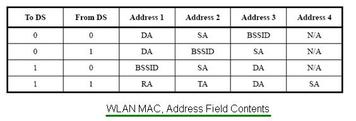Understanding WLAN Frame Structures: 802.11a/b/n/ac
Advertisement
What is WLAN? This page covers the WLAN frame structure as per the IEEE 802.11 standards, including 11a, 11b, 11n, and 11ac frame structures.
WLAN stands for Wireless Local Area Network. The system has two main components: STATION (STA) and ACCESS POINT (AP).
Though the frame exchange between AP and STA are different, they share a common frame structure as shown below for different variants. WLAN has evolved since 1997 with various standards to cater for different data rate/distance specifications.
802.11a WLAN Frame Structure

The figure depicts the 802.11a WLAN frame, which consists of three parts: preamble, header, and data.
- Preamble: About 12 symbols in length and referred to as the PLCP preamble. It is used for synchronization purposes.
- Header: Mainly used to carry the modulation-code rate of data, length, and service bits. It is always BPSK 1/2, so that after synchronization is done, the device can demodulate the header and obtain necessary information to further decode the data part.
- Data: The data part carries MAC frames, and CRC is appended for error checking purposes.
Type and subtype fields transmitted in the SERVICE field define various frames required to establish and maintain a WLAN link between AP and STA.
802.11b WLAN Frame Structure


Based on the rate supported by 11b compliant devices (1, 2, 5.5, and 11 Mbps), there are different modulation techniques and preambles supported as mentioned below:
- 1 Mbps Data rate: DBPSK modulation, DSSS scheme, long preamble, 1 bit/symbol
- 2 Mbps Data rate: DQPSK modulation, DSSS scheme, long/short preamble, 2 bits/symbol
- 5.5 Mbps Data rate: CCK modulation, CCK scheme, long/short preamble, 4 bits/symbol (first 2 bits DQPSK modulated and next 2 bits CCK modulated)
- 11 Mbps data rate: CCK, long/short preamble supported, 8 bits/symbol, first 2 bits DQPSK and next 6 bits QPSK
802.11n WLAN Frame Structure



WLAN 11n devices have support for three modes: legacy mode, mixed mode, and green field mode. As per these modes, 11n devices follow different frame structures to communicate with legacy devices (compliant to 11a/11b/11g) as well as other 11n devices.
L-STF, L-LTF, and HT-LTF are used as preambles for synchronization purposes. L-SIG and HT-SIG are used as headers, which carry the length and rate of the data part carried in the frame.
The data part is used to carry the mac control/management frame as well as information to be exchanged between WLAN devices.
802.11ac WLAN Frame Structure

The 802.11ac frame consists of L-STF, L-LTF, L-SIG, VHT-SIG-A, VHT-STF, VHT-LTF, VHT-SIG-B, and the Data part. To know each field in detail, refer to the 11ac frame format.
Frame Structure of Wireless Standards and Technologies
The frame structures of various wireless standards/technologies are mentioned below. It includes WiMAX, WLAN, Zigbee, GSM, GPRS, UMTS, LTE, TD-SCDMA, GPS, SDH, 11ac WLAN, AMPS, Ethernet, VLAN, etc.
- WiMAX physical layer Frame Structure as per 802.16d and 802.16e standards
- WiMAX MAC layer Frame Structure as per OFDM 802.16d standard
- Zigbee RF4CE Frame Structure
- Zigbee physical layer Frame Structure
- Zigbee MAC layer Frame Structure
- GPRS Frame Structure
- GPS Frame Structure
- LTE Frame Structure
- TD-SCDMA Frame Structure
- UMTS Frame Structure
- SONET Frame Structure
- SDH Frame Structure
- 802.11ac PHY Frame Structure
- 802.11ac MAC layer Frame Structure
- WLAN Frame Structure as per 802.11a, 11b, 11n, 11ac standards
- AMPS Frame Structure
- Ethernet Frame Structure
- VLAN Frame Structure
- GSM Frame Structure
Advertisement
 RF
RF


